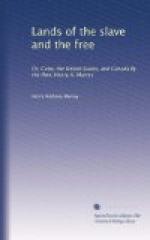In the purging-house, these moulds are all ranged with the point of the cone down, and gutters below. A layer of moist clay, about two inches deep, is then placed upon the sugar at the broad end of the cone, and, by the gradual percolation of its thick liquid, carries off the remaining impurities. When this operation is finished, the cones are brought out, and the sugar contained therein is divided into three parts, the apex of the cone being the least pure, the middle rather better, and the base the most pure and looking very white. This latter portion is then placed upon strong wooden troughs, about six or eight feet square. There, negroes and negresses break it up with long poles armed with hard-wood head, trampling it under their delicate pettitoes to such an extent as to give rise to the question whether sugar-tongs are not a useless invention. When well smashed and trodden, it is packed in boxes, and starts forth on its journeys; a very large proportion goes to Spain. The two least pure portions are sent to Europe, to be there refined. Such is a rough sketch of the sugar-making process, as I saw it. All the machinery was English, and the proprietor had a corps of English engineers, three in number, to superintend the work. In our roadless trips to various parts of the plantation, we found the advantage of the Volante, before described; and though three horses were harnessed, they had in many places enough to do. We stayed a couple of days with our kind and hospitable friends, and then returned to Havana.
No pen can convey the least idea of the wonderful luxuriance of vegetation which charms the eye at every step. There is a richness of colour and a fatness of substance in the foliage of every tree and shrub which I never met with before in any of my travels. The stately palm, with its smooth white stem glittering in the sunbeams like a column of burnished silver; the waving bamboo growing in little clumps, and nodding in the gentle breeze with all the graceful appearance of a gigantic ostrich plume; groves of the mango, with its deep and dark foliage defying the sun’s rays; the guava, growing at its feet, like an infant of the same family; the mammee—or abricot de St. Domingue—with its rich green fruit hanging in clusters, and a foliage rivalling the mango; the dark and feathery tamarind; the light




